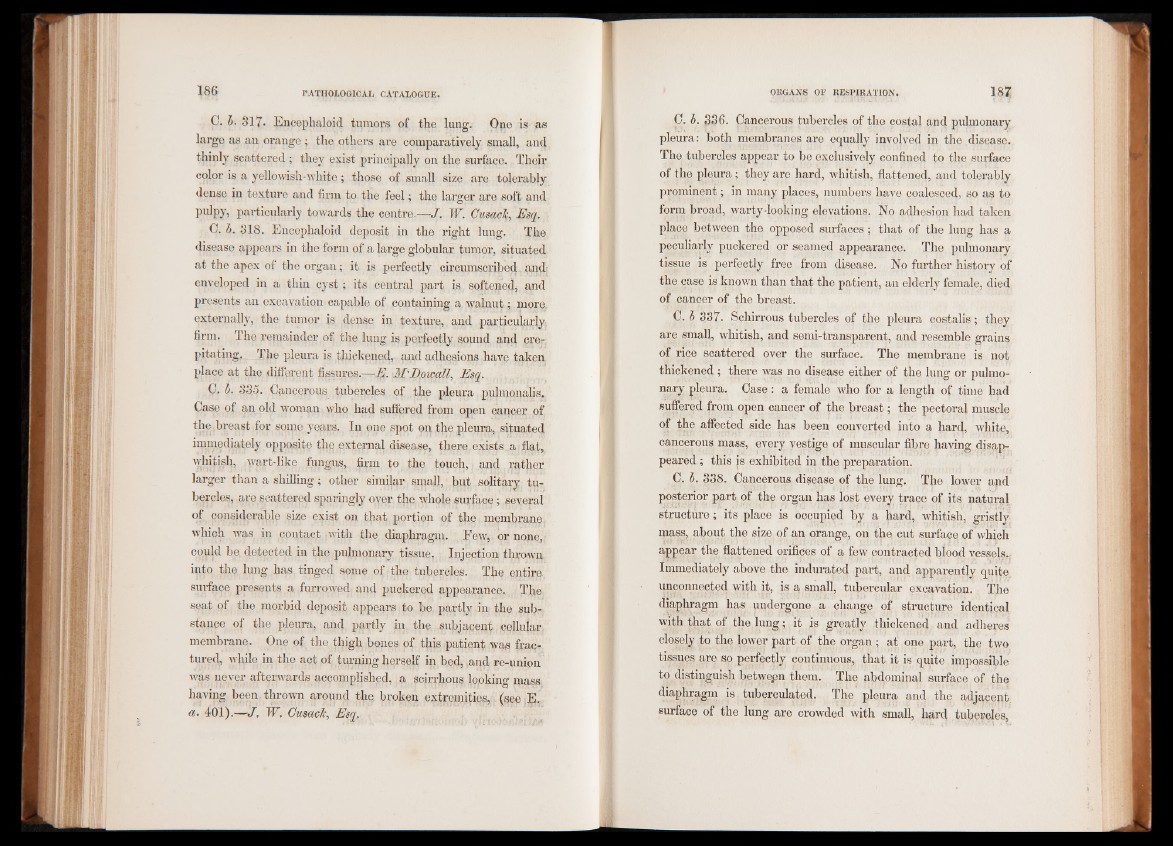
0. b. 317- Encephaloid tumors of the lung. One is as
large as an orange ; the others are comparatively small, and
thinly scattered ; they exist principally on the surface. Their
color is a yellowish-white ; those of small size are tolerably
dense in texture and firm to the feel; the larger are soft and
pulpy, particularly towards the centre.—J. W. Cusack, Esq.
0. b. 318. Encephaloid deposit in the right lung. The
disease appears in the form of a large globular tumor, situated
at the apex of the organ; it is perfectly circumscribed and
enveloped in a thin cyst; its central part is softened, and
presents an excavation capable of containing a, walnut; more,
externally, the tumor is dense in texture, and particularly
firm. The remainder of the lung is perfectly sound and crepitating,
_ The pleura is thickened, and adhesions have taken
place at the different fissures.—E. MlD.ov?att, Esq.
0, b. 335. Cancerous tubercles of the pleura pulmonalis.
Case of an old woman who had suffered from open cancer of
the breast for so.rne years. In one spot on the pleura, situated
immediately opposite the external disease, there, exists a flat,
whitish, wart-like fungus, firm to the touch, and rather
larger than a shilling; other similar; small, but solitary, tubercles,
are scattered sparingly oyer tfie whole surface; several
of considerable size exist on that portion of the membrane.,
which was in contact with the diaphragm. Eew, or none,
could be, detected in the pulmonary tissue. Injection thrown
into the lung has tinged some of the tubercles. The entire
surface presents a furrowed and puckered appearance. The
seat of the morbid deposit, appears , to be partly in the substance
of the pleura, and partly in the subjacent cellular
membrane. One of the thigh bones of this patient was fra<^
tured, while in the act of turning herself in bed, and re-union
was never afterwards accomplished, a scirrhous looking mass,
having been thrown around tfie, broken extremities, (see E.
a. 401).—J, W. Cusack, Esq,.
C. b. 336. Cancerous tubercles of the costal and pulmonary
pleura: both membranes are equally involved in the disease.
The tubercles appear to be exclusively confined to the surface
of the pleura; they are hard, whitish, flattened, and tolerably
prominent; in many places, numbers have coalesced, so as to
form broad, warty-looking elevations. No adhesion had taken
place between the opposed surfaces; that of the lung has a
peculiarly puckered or seamed appearance. The pulmonary
tissue is perfectly free from disease. No further history of
the case is known than that the patient, an elderly female, died
of cancer of the breast.
C. b 337. Schirrous tubercles of the pleura costalis; they
are small, whitish, and semi-transparent, and resemble grains
of rice scattered over the surface. The membrane is not
thickened ; there was no disease either of the lung or pulmonary
pleura. Case : a female who for a length of time had
suffered from open cancer of the breast; the pectoral muscle
of the affected side has been converted into a hard, white,
cancerous mass, every vestige of muscular fibre having disappeared
; this is exhibited in the preparation.
0. b. 338. Cancerous disease of the lung. The lower and
posterior part of the organ has lost every trace of its natural
structure; its place is occupied by a hard, whitish, gristly
mass, about the size of an orange, on the cut surface, of which
appear the flattened orifices of a few contracted blood vessels.
Immediately above the indurated part, and apparently quite,
unconnected with it, is a small, tubercular excavation. The
diaphragm has undergone a change of structure identical
with that of the lung; it is greatly thickened and adheres
closely to the lower part of the organ ; at one part, the two
tissues are so perfectly continuous, that it is quite impossible
to distinguish between them. The abdominal surface of the
diaphragm is tuberculated. The pleura and the adjacent
surface of the lung are crowded with small, hard tubercles.